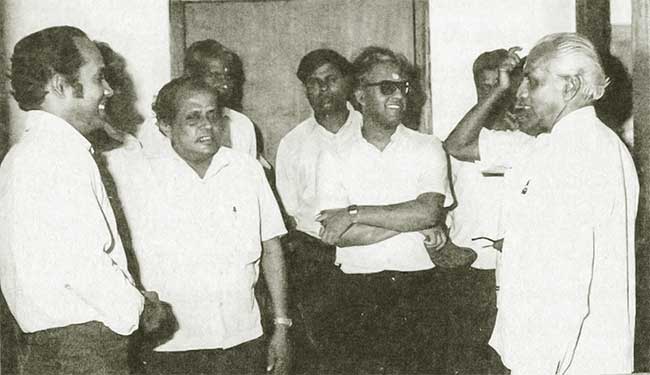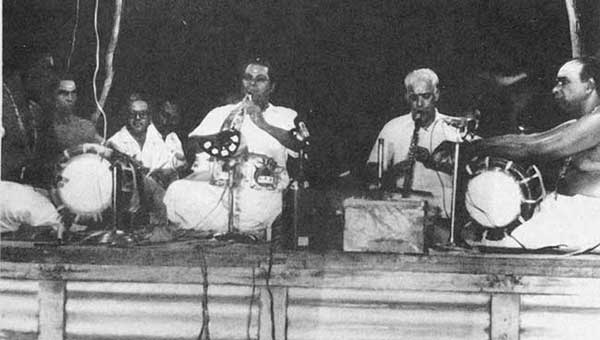Visit to Jaffna and the evolving Tamil political scene
Posted on February 13th, 2023
Excerpted from volume two of Sarath Amunugama’s autobiography Courtesy Island

Excerpted from volume two of Sarath Amunugama’s autobiography
While tensions were rising between the two communities in 1978 I suggested to my Minister Wijetunga that we should visit the Jaffna peninsula for an inspection tour since Kokavil had a radio transmitter and the Japanese planners were proposing the erection of a TV transmitter also in the same location.
Wijetunga was initially reluctant but after we did the preliminary planning he agreed to my proposal and was warmly commended by the President as other Ministers were increasingly reluctant to go northwards. I had no qualms about this tour because my Kandy and University friend Lionel Fernando was the popular GA of Jaffna. He and his wife Somalatha Subasinghe were well settled there and were living in the GAs historic bungalow.
I found that Lionel had gathered around him several of our Tamil friends from Peradeniya University days. Also the Jaffna Campus had been opened recently and the staff under Vice Chancellor Vidyananthan, who was a long term resident at Peradeniya, had created an academic ambience familiar to us from our undergraduate days. There were many teachers from the South at the Jaffna campus as many permanent positions were made available in the new University.
Remembering our Peradeniya days, Lionel had arranged a Sinhala film festival. Robin Tampoe, a great local film personality who lived in Colombo, had provided a cinema in Jaffna for this event free of charge and the hall was filled to capacity. Wijetunga opened the festival and I gave a speech which was translated into Tamil by Sivananthan, my colleague from Arunachalam Hall, who later joined the SLAS. Siva became GA Galle some years later and was popular with the public there who protested when he was transferred.
We lived for several days in the Governor’s bungalow in Jaffna located within the Fort. Many Northern MPs who officially boycotted our tour came incognito to the bungalow to greet Wijetunga who was on good terms with them and was ever ready to accommodate requests from Parliamentarians for telephone connections.
Many Tamil officers who had worked with him before retirement and had settled down in Jaffna invited us for ‘thali’ meals with crabs, prawns, murunga and white rice which we gobbled up with relish. The SLBC staff in Jaffna and my University friends arranged a special treat for me by inviting me to participate in a temple music festival which featured classical Dravidian music played by a famous group from Chennai.
When we were taken to the Nallur temple premises I was given the signal honour of being hoisted onto the stage to sit with the musicians. From the stage I saw a wonderful sight. Thousands of devotees, particularly young people, were recording the sacred music on their transistor units. It was a sea of hand held transistors which surrounded the stage. Taken aback by this phenomenon which was not seen in the south, I inquired from my friends and was told that a large number of ‘boys’ had gone to the Middle East for employment and had sent back money and equipment to their families.
As a sociologist I realised that Middle Eastern employment was creating a new dynamic among the young Tamils. Earlier they looked on employment in the south, particularly in government service, as their lifeline. Education was the passport to a good life and the privileged Tamils who had lived in the South were happy to forge enduring links with their neighbors.
Southern politicians of both the SLFP and the UNP were making it difficult for them to continue in that spirit as they perceived increasing pressures on them because of their ethnicity. Tamil politicians highlighted these differences and the country was set on a path of confrontation and non-cooperation. The economic links which drew the communities together was based on their dependence on the south. Now those links were being snapped as the Middle East, and later the West, became a better source of income and employment.
Like in the South, the failing economy could not cope with the rising population and its high expectations. The classical ‘push and pull’ known to demography was now in operation and it boded ill for ethnic harmony in Sri Lanka. This was my ‘take away’ from the musical soiree in Nallur. Before long the country was set inevitably on the slippery path of racial conflict. The photograph reproduced in this book of my presence on stage in Nallur is a tragic reminder of the bonds of friendship that we as young undergraduates shared prior to the shooting war which started soon after and lasted for nearly 40 years with irreparable damage to both sides.
The Minister and I then went to Kokavil where both radio and TV masts were erected to transmit to the peninsula as well as the Wanni. It was so well located that we had viewers from the southern tip of South India who were enamored of our entertainment in color TV which contrasted with the dreary black and white instructional programmes of Doordarshan in India.
We also had reports of large scale smuggling of Japanese TV receiver sets to India via Velvettithurai, the smuggling centre of Jaffna fishermen. These were the sea lanes and fishing craft that the LTTE used when they began smuggling arms and fighters to South India and back. Viewed sociologically, it was no coincidence that Prabhakaran was of the Karaiyar or fisher caste which had an affinity to the sea.
Without the sea and sanctuary in coastal villages of Tamil Nadu the LTTE could not have sustained their war. They secured their rear through the sea and the South of India which were Karaiyar territory. The Tamil Vellalas, the equivalent of the Sinhala Goigama, were looked upon with suspicion by the LTTE. Indian RAW operatives also looked for cracks in the LTTE leadership and recruited Mahendraraja (Mahattaya), a Vellala, as their mole in the top leadership of the LTTE.
Lalith Athulathmudali made a bad strategic mistake in refusing the Indian request to interrogate captured LTTE cadres in Jaffna. Due to turf battles, Lalith flew them down after they was captured at sea in northern waters to Colombo. Many of The LTTE captives committed suicide. It was alleged that the cyanide was given to them by Mahattaya who had been permitted to meet the detainees by the IPKF. This contributed to the breach of the accord by Prabakaran and the resumption of hostilities.
India and The Tamil Question
JRJs growing estrangement with India played into the hands of the LTTE. When Mrs. B was the Prime Minister she had an excellent relationship with Indira Gandhi. It was a friendship which was signified in a masterstroke of making Indira a personal guest of the PM and lodging her in Temple Trees when she attended the Colombo non-aligned meeting in 1976. But months before the local general election of 1977 the Indian Congress was beaten at the polls and Indira was sent into the political wilderness.
She was replaced by Morarji Desai of the Janata Party. He and JRJ, both oldsters and late comers to the highest office, hit it off from the very beginning and created a situation wherein India was supportive of the UNP’s initiatives. I remember Morarji’s state visit to Sri Lanka following JRJ’s own state visit to India a few months earlier. He came with a family entourage led by his daughter.
Journalists who earlier had a field day publicizing the Indian PM’s penchant for drinking urine, told us that Morarjis daughter went on a shopping spree and bought up all the cosmetics available in a Colombo department store. Obviously she could not shop to her hearts content in Bombay because of her father’s constant calls for austerity. Morarji himself enjoyed his visit and assured JRJ that he trusted him to settle the grievances of the Tamil community.

But before midterm in JRJ’s first tenure in office, Indira had maneuvered the Janata government out of power and had become PM again. She did not forget the cosying up to Morarji Desai by JRJ and their joint attacks on her thinking that she will not come back. But come back she did and proceed to intervene in Sri Lanka’s internal affairs by encouraging the Tamil militants. As later documentation showed she brought in her newly formed Research and Analysis Wing [RAW] as a player in the Sri Lanka situation just as she had done before with Pakistan prior the invasion of East Bengal.
At this stage there were several militant groups among the disaffected Tamil youth. They were led by Uma Maheshwaran (PLOTE), Sri Sabaratnam (EPRLF), Douglas Devananda (EPDP) and Velupillai Prabhakaran (LTTE). For some time they worked together but soon differences arose, partly due to RAW intervention. They started to quarrel and even eliminate each other’s cadres. After the murder of Duraiappah, the Mayor of Jaffna by Prabhakaran the next murder attempt concerned our ministry.
Tom Pathmanathan who was a senior CCS was the additional secretary of my ministry. His wife was a rich and affable lady named Ranga from Eastern Province. Mrs. Pathmanathan’s brother, a businessman from Batticaloa, had linked with the Federal Party and was elected to Parliament. Sometime later he had left his party and was operating as an independent MP. One day about noon we received an urgent message that he had been shot. We rushed to his house in Charles Way and found that he had been taken to hospital. Later we were told that the assailant was Uma Maheshwaran.
Fortunately he was not successful in killing the MP But the MP resigned and his place was taken by his sister. The militants were beginning to strike; and the Federal Party was put on notice that the path of negotiation no longer had the assent of the Tamils. After much discussion District Development Councils were established to decentralize, not devolve, some powers to the periphery in the midst of opposition from extremists of both sides.
The UNP had managed to lure some politicians from the Federal Party as well as activate their own followers to present a party slate for the DDC elections. It was led by a popular ex-Principal who also was a former Member of Parliament. He was murdered on the eve of the election. The militants were on the ascendant. At this stage RAW got into the act and began to give weapons and weapons training to the militants as they had done with the Bangladeshi fighters (The Mukti Bahini) prior to their invasion and founding of Bangladesh.
The scenario was dangerously similar but our Foreign Ministry which should have been our eyes and ears was caught napping. They were pawns in an ego trip of their Minister Hameed. This was compounded by JRJ’s desire to be his own Foreign Minister. He was undertaking a difficult balancing act and he wanted full control. This decision rather than becoming a solution turned out to be the problem.